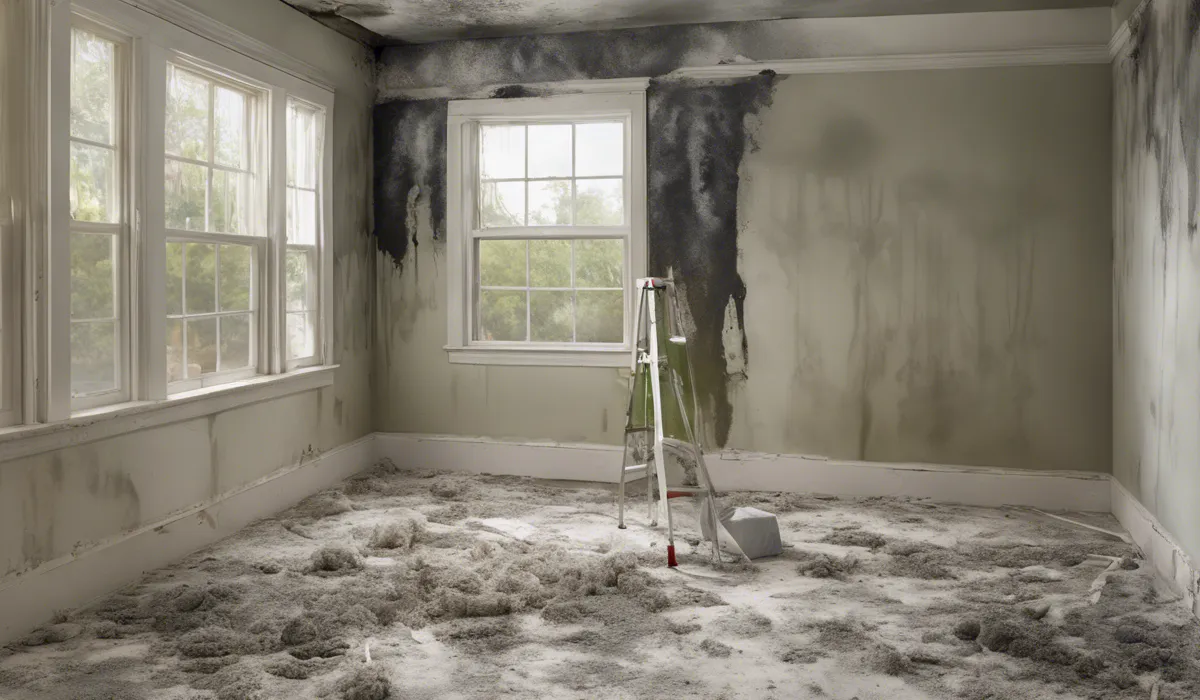It’s not advisable to paint over mold as it merely covers, not resolves, the issue. Mold must be thoroughly cleaned and the underlying moisture problem fixed before repainting to prevent health risks and further damage.
Understanding Mold and Its Dangers

What Mold Is and Its Common Types?
Mold is a type of fungus that grows in damp environments. It reproduces by releasing spores that float through the air. Molds come in various colors and shapes.
The most common types found in homes include Aspergillus, Cladosporium, and Stachybotrys chartarum, often called black mold. These molds can grow on walls, ceilings, and other surfaces where moisture is present.
Health Risks of Mold Exposure
Being around mold can be harmful to your health. People can have allergies to mold that cause symptoms like sneezing, red eyes, and skin rashes.
Mold can also trigger asthma attacks in people with asthma. Some molds produce toxins, known as mycotoxins, which can lead to serious health issues, especially when exposure is prolonged.
Causes of Mold Growth in Homes
Mold grows where there is moisture. This can come from leaking pipes, floods, or high humidity.
Homes with poor ventilation also create an environment where mold can thrive. It is essential to fix these issues to stop mold from growing.
The Misconception of Painting Over Mold
Some people think they can fix a mold problem by painting over it. This is not a good idea. Painting over mold only hides it and does not take care of the root problem.
The mold can continue to grow underneath the paint and can still cause health problems and damage to your home.
Proper Mold Remediation Techniques

Addressing the Moisture Source
To stop mold from coming back, you first have to fix any moisture problems. This could mean repairing leaks, using dehumidifiers, or improving ventilation in your home. Without taking care of the moisture, the mold will likely return even after you clean it up.
Safe Mold Removal Steps
When removing mold, it is important to wear protective gear like gloves, masks, and goggles.
This keeps you safe from mold spores. You should seal off the area where you are working to prevent spores from spreading to other parts of your home. Use the right cleaners to kill the mold and be sure to dry the area completely when you are done.
When to Call the Pros?
If mold covers a large area or is in hard-to-reach places, it may be best to call professional mold remediators.
They have special tools and knowledge to safely and effectively remove mold. This is also a good idea if you have health problems that could be made worse by mold exposure.
Preventing Future Mold Growth
After cleaning up the mold, take steps to prevent it from coming back. Keep your home dry, use mold-resistant materials when making repairs, and regularly check for signs of moisture or mold.
A little prevention can save a lot of trouble later on.
Painting After Mold Remediation

Ensuring Complete Mold Removal
Before you start painting, make sure all the mold is gone and the area is dry. You might need a professional to confirm that the mold has been completely removed. Painting over any leftover mold is not safe and can lead to problems down the road.
Choosing Mold-Resistant Paint
There are paints and primers made to help prevent mold. These products contain chemicals that resist mold growth.
They can be a good choice for areas that tend to be damp or have had mold problems before. Always follow the manufacturer’s directions when using these products.
Tips for Painting Previously Mold-Affected Areas
When painting an area that had mold, clean the surface well and let it dry. Use a primer designed for mold prevention first, then apply the paint. Make sure to cover every part of the surface to give the best protection against mold.
Long-Term Mold Prevention on Painted Surfaces
To keep mold from coming back, control moisture in your home. Use exhaust fans in bathrooms and kitchens. Fix any leaks right away.
Keep painted surfaces clean and dry. By taking these steps, you can help stop mold from growing on your painted walls.
FAQs About Painting Over Mold
Can you safely paint over mold on your walls?
No, it is not safe to paint over mold. It hides the mold but does not eliminate the health risks or the problem itself.
What should be done before repainting a surface that had mold?
The mold must be thoroughly cleaned and the source of moisture fixed before repainting to prevent further mold growth.
Can painting over mold cause health issues?
Yes, painting over mold can still lead to health risks as the mold continues to grow beneath the paint.
Are there paints that can prevent mold growth?
There are mold-resistant paints, but they should not be used as a primary solution to existing mold problems.
How do you ensure mold doesn’t return after repainting?
After cleaning the mold, address any moisture issues and use mold-resistant paint as a preventative measure.
Final Thoughts
Painting over mold is ill-advised as it only conceals the problem without addressing the root cause. Effective mold treatment requires thorough cleaning and rectification of any underlying moisture issues.
Ensuring these steps are completed before repainting is crucial to avoid potential health risks and further property damage.
